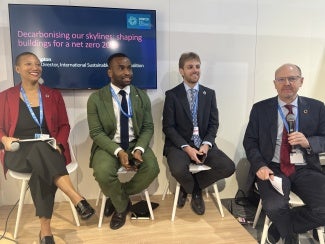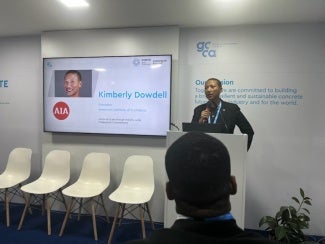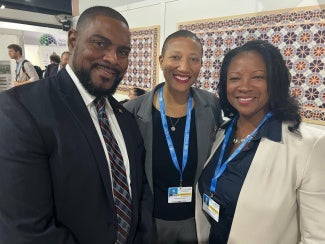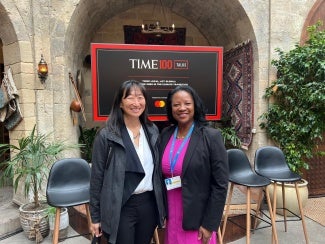
Adaptive reuse and net zero standards: AIA's key focus at COP29
AIA's delegation to the United Nations Climate Change Conference is ensuring that architects have a seat at the table.
For the fourth year in a row, AIA is advocating for architects at the United Nations Climate Change Conference (COP29) in Baku, Azerbaijan.
The stakes are high for the United States and the world at large. It’s almost certain that 2024 will rank as the warmest year on record, according to the National Centers for Environmental Information, and these high temperatures are bringing increasingly unpredictable weather to U.S. communities. In 2023, the U.S. experienced 28 natural disasters that caused over $1 billion in damages each.
On the heels of these sobering statistics, AIA has sent its fourth delegation to COP29 this year to ensure that architects, who play a critical role in climate resilience, have a seat at the table. AIA’s advocacy at this year’s summit includes discussing the importance of advancing net zero standards for buildings and emphasizing the need for the reuse and adaptation of existing buildings, in tandem with other strategies, to achieve decarbonization at scale.
AIA 2024 President Kimberly Dowdell, AIA, addressed an audience at the Association for Renewable Energy & Clean Technology Pavilion on Wednesday, November 13, highlighting the ways in which existing buildings will play a critical role in reaching the industry’s zero emissions goals by 2050, and pointing out that over half of the U.S. building stock is over 40 years old.
“Simply put, there is no path to zero emissions without directly addressing America’s 325 billion square feet of existing built environment,” she said, pointing attendees toward AIA’s Today’s Buildings for Tomorrow: A Guide to Building Reuse for Climate Action, a resource that offers guidance for renovating and adapting existing buildings to mitigate and adapt to climate change.
Dowdell addressed programs like AIA’s 2030 Commitment, Design Data Exchange, and AIA Materials Pledge in remarks at a Thursday, November 14 session at the Concrete Future Pavilion titled “Building Net Zero Standards and Turning Pledges into Action.” She pointed out that this year’s 2030 Commitment By the Numbers report highlights excellent progress in the areas of net zero projects, embodied carbon, and renewable energy data. These types of pledge programs, she emphasized, are crucial to hitting climate goals, but support infrastructure is essential.
“We can see through the improvements in our data that pledges can work if we provide the tools to support them,” she said.

Innovative solutions
AIA 2025 President-elect Illya Azaroff, FAIA, is attending COP for the third time. He says that AIA’s continued presence at the yearly summit has gone a long way toward establishing the organization’s bona fides as a global partner ready to roll up its sleeves and do the work.
“Over the years attending COP, we have gained a certain degree of agency among the global community working to advance resilient, sustainable, healthy, and equitable communities,” he says. “Our messaging [this year] surrounds our values, noting that the AIA and its 98,000-plus members are willing partners to establish these global goals, including every town and city along the way.”
Azaroff says that because the AEC industry, and particularly architects, are an integral part of climate solutions, it’s essential for them to have a seat at the table during the COP29 conversations. It’s also important for representatives like Azaroff to be present to identify new opportunities where AIA and architects can have an impact, access new streams of funding (particularly for vulnerable populations), and inform avenues for climate action and implementation.
“What has been clear is that there has not been enough action on climate,” he says. “[Architects] are key to creating a better future by translating goals of the community to meet national implementation targets and agreements on sustainable development goals.”
In addition to Dowdell and Azaroff, AIA delegates at COP29 include Lakisha Ann Woods, CAE, EVP/Chief Executive Officer; Vicky Schneider, senior advisor; and Derek Washam, senior director of global and industry engagement at AIA. In tandem with counterparts like the Royal Institute of British Architects and the Global Alliance for Buildings and Construction, AIA is part of a strong global coalition ensuring a sustainable future for the global AEC industry.
“Architects are systems thinkers, and we can decode systems that can be made more efficient and transformed into innovative solutions to achieve the world’s sustainable development goals,” Azaroff says.








